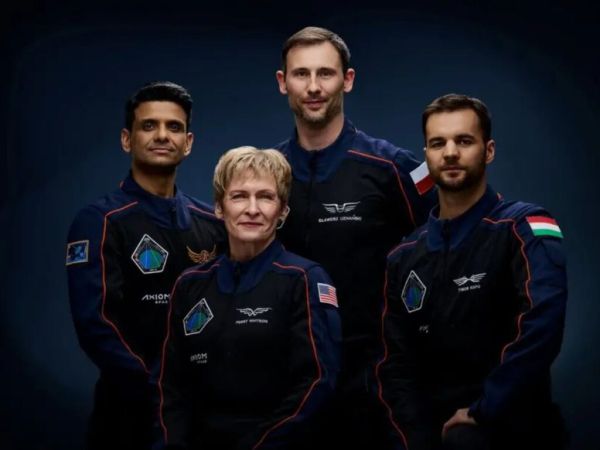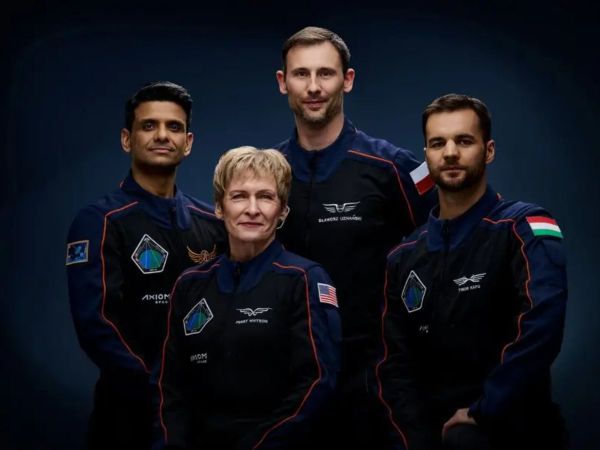

After weeks of anticipation and multiple delays, Group Captain Shubhanshu Shukla has officially taken flight. Aboard the SpaceX Falcon 9 rocket, Shukla, along with three international crewmates, lifted off from NASA’s Kennedy Space Center in Florida early Wednesday morning, marking a huge moment for India and the global space community.
Shukla, a 39-year-old fighter pilot with the Indian Air Force, is now the second Indian ever to venture into space, more than four decades after Wing Commander Rakesh Sharma’s historic flight in 1984.
A Powerful Launch with History Behind It
The rocket lifted off from Launch Complex 39A — the same launchpad that once sent Neil Armstrong to the moon during the Apollo 11 mission in 1969. The launch happened right on schedule at 12:01 PM IST, after a brief concern over weather data was quickly resolved just minutes before liftoff. “Stage 2 of Axiom Mission has been activated,” NASA confirmed, shortly after announcing the Main Engine Cut-Off (MECO) was successful.
This marked the beginning of the mission’s orbital journey to the International Space Station (ISS), where the crew is expected to dock by 4:30 PM IST on June 26.
The Crew of Axiom Mission 4
Shukla is serving as the pilot on the Axiom Mission 4 (Ax-4), a commercial mission operated by Axiom Space in collaboration with NASA and SpaceX. Alongside him are:
-
Dr. Peggy Whitson, former NASA astronaut and the mission commander
-
Slawosz Uznanski-Wisniewski, a European Space Agency (ESA) astronaut from Poland
-
Tibor Kapu, a Hungarian astronaut under the HUNOR space program
Together, the four-member crew will spend about two weeks aboard the ISS, conducting science experiments, outreach programmes, and commercial activities.
Shukla’s Journey: A Nation’s Pride
Before liftoff, Group Captain Shukla had been in isolation for over a month — a standard precaution to ensure crew health ahead of a space mission. His mission is not just technical; it carries immense symbolic value for India, with 1.4 billion people watching proudly as the second ‘Gaganyatri’ soars into orbit.
This mission is part of “Mission Akash Ganga,” which was announced during Prime Minister Narendra Modi’s state visit to the US in June 2023. The Indo-US collaboration allowed India to secure a seat aboard the mission for a reported ₹550 crore, strengthening ties between ISRO and NASA.
Scientific Goals and Outreach
The Ax-4 mission plans to conduct 60 scientific experiments, including seven proposed by Indian researchers. These experiments aim to improve understanding in areas like microgravity, health sciences, and material behavior in space.
Shukla is also expected to take part in live interactions from space, including one with a VIP guest back on Earth — a rare outreach moment that could inspire a whole new generation of Indian scientists and space explorers.
Mission Delays and Technical Challenges
Originally scheduled for May 29, the mission faced several delays due to bad weather and technical issues. A leak in the oxidizer system and other minor glitches forced NASA and SpaceX to push back the launch date multiple times. June 25 was the sixth launch date announced — and finally, a successful one.
About the Falcon 9 Rocket
The spacecraft used for this mission is SpaceX’s Falcon 9, a medium-lift, two-stage rocket that has become a workhorse in modern space travel.
Its reusable first stage also aids in the reduction of the costs and the turnaround times. The Falcon 9 is a reliable launch vehicle today with 16 successful crewed missions plus a 100% safety record.
A Historic Leap for India
This mission marks nationally — it doesn’t just achieve personally for Shubhanshu Shukla. As he adventures to space, he carries the dreams of an entire country. He carries not only the scientific goals that he has.
ISRO is gearing up toward its own human spaceflight programme (Gaganyaan), so Shukla’s flight on the Axiom-4 mission provides valuable experience and visibility on the global stage. It reaffirms the growing role of India. The achievement means much more than anything else for space exploration’s future.
When the ISS is reached, the crew will start planned tasks, and they will work with scientists plus astronauts. The mission returns after a period of two weeks assuming conditions in orbit allow as reentry protocols permit.
The post Shubhanshu Shukla Blasts Off to Space, Becomes India’s Second Astronaut After 40 Years appeared first on NewsX.
-
After RCB’s IPL 2025 title win, AB de Villiers set to return to T20 cricket with this league

-
Sanju Samson set join NEW franchise, KCA chairman confirms auction registration

-
Meet actor who once played villain roles in Ajay Devgn, Akshay Kumar’s films, left Bollywood to become Maulana, is now hard to recognise, he is…

-
Meet man, who receives salary 800 times higher than that of an average employee, CEO of THIS big company, his salary is…, he owns…

-
GPAT 2025 result likely today at natboard.edu.in; check time, steps to download and other important details
